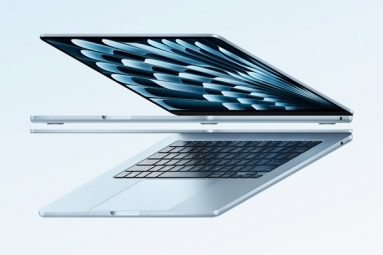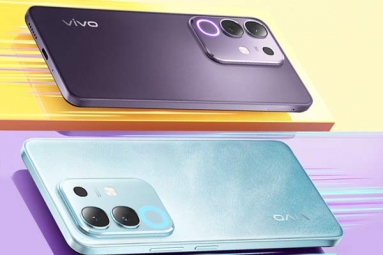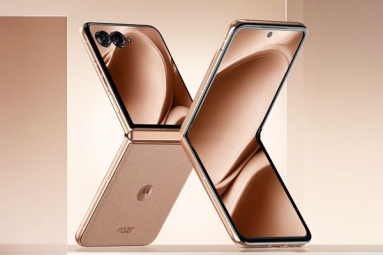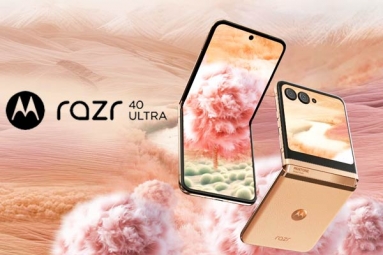
(Image source from: x.com/motorolaindia)
The Motorola Razr series is one of the most famous mobile phones in human history. It also sold well and made Motorola, now part of Lenovo, a lot of money. Flip phones took the foldable/foldable route in late 2020 and are now in their fifth generation. Two smartphones were launched this year: the Razr 50 Ultra and the Razr 50. Although the latter is identical to last year's model, the new Razr 50 represents a significant evolution in terms of design compared to the Razr 40. The Razr 50 from Motorola is in many ways cheaper than the Razr 40 Ultra, but the price of this phone is 200 million Tomans. 64,999 in India and is available with just 8GB RAM and 256GB storage. Is this a phone you should consider over the more expensive Ultra or Samsung phones? Should you upgrade from the Razr 40?
Dimensions (Closed) - 73.99 x 88.08 x 15.85mm
Dimensions (Open) - 73.99 x 171.30 x 7.25mm
Weight - 189g
Colours - Beach Sand, Koala Grey, Spritz Orange
Outer screen - 3.63-inch OLED, 1056 x 1066 pixels, 90Hz
Internal flex screen - 6.9-inch pOLED LTPO, full-HD+, 120Hz, HDR10+
Protection - Gorilla Glass Victus (Outer)
OS - Android 14
UI - Hello UI
Latest security patch - August 1st
Processor - MediaTek Dimensity 7300X
RAM - 8GB LPDDR4X
Storage - 256GB UFS 2.2
Main - 50-megapixel, f/1.7, OIS
Secondary Ultrawide - 13-megapixel, f/2.2, 120 degree FoV
Inner selfie - 32-megapixel, f/2.4
Capacity - 4,200mAh
Charging - 30W
Charger - 33W included in-box
The new Motorola Razr 50 looks very different from the front than the Razr 40. The rounded corners, curved sides, smooth hinge design on the back and the vegetable leather finish on the bottom of the phone are retained. The lower half of the back panel is covered in vegetable leather, while the top is covered in a thin strip of vegetable leather. The vegan leather cover offers excellent support. I received a unit of Spritz Orange for testing. It is a unique color option that will attract everyone's attention. The arrangement of the buttons corresponds to that of last year's model. There are volume and power buttons on the right edge of the top half. The power button also doubles as a fingerprint scanner and works well. The SIM tray tool is located on the left side of the top half. There is a microphone at the top. Finally, at the bottom of the bottom half are the USB Type-C port, speaker and microphone.
One of the most important design aspects of the Razer 50 is obviously the hinge and mechanism. Motorola says it has redesigned the hinge to increase durability while reducing noise by around 30 percent compared to previous models. The hinge is also said to have an IPX8 dust rating, which we think is pretty effective. However, please be careful as the screen may be damaged if dust remains on the inner panel when closed. The hinge cover is made of stainless steel and the phone frame is made of 6000 series aluminum. All surfaces are smooth satin finish, giving your phone a premium look. The hinge also has a short range of motion, so the display only stays open at certain angles. If this angle is exceeded, the phone will automatically close or open. This is great because the hinge means you can easily open the phone with one hand. However, opening the phone with one hand is still difficult. The hinge allows for special uses such as tent, camcorder and standing desk mode.
A new floating plate in the hinge is designed to reduce pressure on the folding plate and help reduce wrinkles. Motorola advertises the Razr 50 as virtually wrinkle-free, but that's not the case. Wrinkles are visible, but not as noticeable when you watch videos scrolling through Instagram. You only feel its presence when you swipe your finger across the internal display or look at the screen from a certain angle. The Motorola Razr 50 has received significant improvements in the display area, but only externally. Instead of the smaller, less functional display that came with the Razr 40, it now features a 3.63-inch 10-bit OLED panel that has a 90Hz refresh rate, up to 1700 nits of peak brightness, and HDR 10 -Provides support. This panel has a cutout for the camera and LED flash. You can also watch videos on this site, but we do not recommend it. However, it is good for playing some pre-installed games on the screen. The screen will be brighter and easier to read even outdoors.
Opening the phone reveals a larger-than-average 10-bit OLED display made of flexible plastic, offering a 120Hz refresh rate, maximum brightness of up to 3000 nits, and support for HDR 10+. This panel has three color modes: natural, radiant and vibrant. It's best to use the Natural option, as the other modes tend to emphasize the colors a bit too much. The internal display has a 22:9 aspect ratio, which is great for watching movies, but not for watching 16:9 content on YouTube. The panel is easy to read in direct sunlight, but it becomes a little more difficult. Both displays support Widevine L1, so you can enjoy content on Netflix and other streaming apps in full HD quality. Software is also an important part of foldable phones and Motorola has done a great job with Hello UI. It still looks similar to the stock Android device, but some design elements and additional Moto features set it apart. There are some pre-installed apps, but these are not true bloatware and can be removed. There are also several Moto apps and features including Moto Secure, Family Space, Moto Unplugged and Smart Connect.
Motorola also has some AI tools to help you create wallpapers. There's Style Sync and Magic Canvas, the latter of which requires a Moto account. Style Sync lets you create wallpapers from captured photos, while Magic Canvas lets you create images using text messages. You can run almost any program on the external display. There are several pre-installed games that work well on the screen and are fun. In addition to using apps and games, Motorola also supports using Google Gemini on the screen and is offering 3 months of Gemini Advanced free with the purchase of the Razr 50. The user interface is optimized for external displays, making communication with Gemini easier. As for software support, Motorola promises three years of Android OS and four years of security updates for the Razr 50.
Curiously, the company has opted for a MediaTek chipset for the Razr 50, while the Ultra variant will come with a Snapdragon SoC. The Dimensity 7300X has 8GB of LPDDR4X RAM. I ran some synthetic benchmarks on the phone and the results were satisfactory. Older phones like the Tecno Phantom V Flip performed better in this test. The performance of Dimensity 7300X, a 4nm octa-core processor, is sufficient for everyday tasks such as messaging, calling, using the browser and watching movies. However, when launching applications or multitasking on both devices, you will notice a drop will occur. Outer umbrella and inner umbrella. The transition from program coverage to the main broadcast and vice versa was essentially smooth. You can play with your phone. I tried titles like BGMI and Asfalt 9, both of which worked well. Many games are also available on the front display and it runs very well and without any lags. The phone didn't get too hot while playing.
My phone sometimes lags when I use the camera app to take a photo or switch cameras. In some cases the camera's viewfinder remains blank for a few seconds. Motorola offers a dual-speaker hybrid setup with Dolby Atmos on the Razr 50 that works well. The bass is there and the speakers can be louder. It is suitable for indoor use, but it is recommended to have headphones with you when using it outdoors. The call quality and connection on the phone were very good and I never had a connection drop. However, I did notice some issues with the Wi-Fi connection while playing, but only once.
The main camera is shared with the Ultra, along with a 32-megapixel internal unit. However, unlike the ultra-telephoto lens, the standard Razr 50 has a 13-megapixel ultra-wide-angle lens with autofocus. The overlay screen lets you take prime and ultra-wide selfies, and there's also a split-screen interface for easy shooting. As if the nostalgia of the flip form factor wasn't enough, Motorola has included a video camera mode that prioritizes form over function. Photos from the main camera in bright daylight environments have little to no noise, good detail and dynamic range, but more than decent sharpness and saturation. Green looks greener and the sky looks bluer. If you switch to the ultra-wide camera, the results look completely different, with less detail, darker shadows and color variations. Dynamic range and white balance also don't work well in ultra wide angle mode. You can use photos, but nothing great. 2x digital zoom option and macro mode are also available. The 2x zoom takes good photos in daylight, but there is a lot of noise when you zoom in. On the other hand, macro photography gives good results.
Even in poor lighting conditions, the main camera retains details and shadows well, although the white balance can be disturbed. However, saturation and exposure are handled well. Ultrawide isn't much use in low light unless you have enough light. Night mode is also available, but works better with the main camera. The built-in selfie camera delivers good results in daylight with very realistic skin tones, good colors and a wide dynamic range. There are also very few details. However, for selfies, it is better to use the main external camera as it will give you clearer details.
As for video performance, the Razr 50 can record 4K videos at 30 frames per second with all stabilized cameras. The main camera shoots well in daylight with lots of details and slightly saturated colors. The stability is mediocre, but I'm worried about shaking when walking or running. Motorola claims that it uses artificial intelligence to reduce camera shake, but in reality it doesn't work very well most of the time. The ultra-wide camera doesn't work particularly well with videos. Despite having the same battery capacity as last year, the Motorola Razr 50 offers impressive battery life for a clamshell phone. I used my phone for more than seven hours straight, probably because I did most of my messaging on the external screen. This means you can easily use the phone for a whole day. I just open the screen to use the camera, play games, read email, watch videos, or scroll through Instagram. However, if you continue playing, it will consume a lot of battery. In our battery tests, the phone lasted over 25 hours on a single charge. As for charging, the Razr 50 supports 30W fast charging and it takes about 1 hour and 10 minutes to charge from 10% to full. It also supports 15W wireless charging.
At 64,999 rupees, there are not many options in the market. Check out the Oppo Find N3 Flip. It offers much better performance and a better camera pair. Unfortunately, the external display is difficult to use. Last year's Tecno Phantom V Flip is also there, but not great. It's also a great alternative to the Samsung Galaxy Z Flip 6 if performance isn't your main concern.
The Motorola Razr 50 is a very nice phone with a lot of nostalgia and features that are a bit disappointing due to its processor. The external display is great, it has a great camera setup, good battery life for a dual screen phone, fast charging, IPX8 rating, super compact form factor, AI features, great software and 9999 points. If you don't want to spend a lot of money but want a flip-style foldable device, the Motorola Razr 50 is better in most cases. It's also a decent upgrade over the Razr 40.












